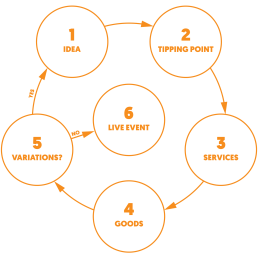LIVE CYCLE
The lifecycle of a live event, or ‘live cycle’, brings together all the strategies, tactics, tools and insights in The Facts Of Live.
The live cycle illustrates what you need at each point of a live event, exhibition or pavilion’s lifecycle: from the very beginning – at its genesis – when the idea first exists, as the project evolves and changes, which it will, and through to being live.
A summary of each of the 6 live cycle steps can be found below. To understand them fully, please read The Facts Of Live book.
1
IDEA
Either you, someone in your organisation or a client have come up with an idea for a live event or a sales, communication or entertainment need (or all three) that can be fulfilled with a live event.
2
TIPPING POINT
The decisions made in the seconds or minutes after an idea gains traction can have a far bigger effect on the value, impact and success of that live event than the decisions you or anyone else you bring on board make further down the line.
This is the tipping point. It’s at this point you need to put the right team and expertise with relevant content and contextual experience in place.
Consult the tipping point choices to double check and determine the best approach for you to adopt by clicking here…
3
SERVICES
The first thing you need are services. You need your core team of four key roles in place, and then any further resources you require. If you don’t have these resources already, you’ll need to find them.
Consult the team structure examples for further guidance regarding the core team you need by clicking here…
Consult the procurement toolkit to understand how to best find or procure the services or talent you need by clicking here…
Even if you are outsourcing all or part of a live event – the goods and services – it is the services you need to focus on first.
4
GOODS
As plans for your live event progress, you are going to need goods: all the equipment, infrastructure and physical requirements, venues, content production, and any other elements.
If you or your team are producing the event, then you will need to procure the goods yourself.
If you have chosen to outsource all or part of a live event, you need a turnkey solution.
Consult the procurement toolkit for guidance on procuring goods or turnkey solutions by clicking here…
5
VARIATIONS?
Nearly all live events, exhibitions and pavilions evolve and change as design, development and planning progress.
Review your live event’s progress regularly. If there are significant changes or new requirements, move back up the cycle to step 1 – the idea – and assess these changes or requirements as you would if you were starting from scratch.
6
LIVE EVENT
Once these each step of the live cycle is complete and there are no more changes, your live event is ready.
If you have followed the approaches, principles and methods detailed in The Facts Of Live book and summarised here, your live event will have maximum impact for the best value possible and with all risks either mitigated or minimised.
Enjoy!
